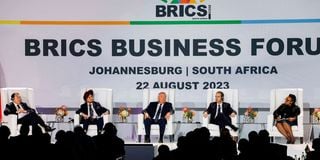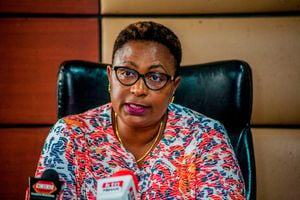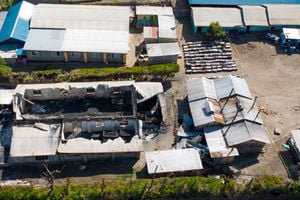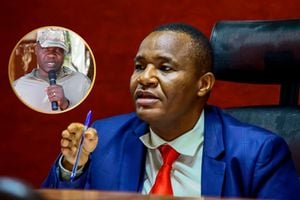Brics leaders gather for summit on more of same old problems

Russia's Sergei Katyrin (centre), Chair of the Brics Business Council from the Russia Chapter, speaks during the 2023 Brics Business Forum in Sandton, South Africa, on August 22, 2023.
There will be routine things in South Africa this week when a gathering of leaders from the BRICS descend on Johannesburg. Photo ops, speeches and plenaries.
But the three-day meeting may also bring something new: applications by other countries to join the bloc may be considered. Yet there could be nothing else substantive.
Brics is a bloc composed of Brazil, Russia, India, China and South Africa. Four of the five heads of state or governments of these countries will be attending during the conference between August 24 and 26. Russian President Vladimir Putin will attend virtually, having decided against travel on the background of an indictment by the International Criminal Court (ICC). It is the fifteenth such gathering in the history of the bloc.
The Brics bloc had been touted as a ‘non-aligned’ alternative international forum to groupings such as the G20, or even the United Nations – but it is not that.
There are hopes, as set out from the formation of the Bric grouping (when South Africa had yet to join), that Brics, plus some new members, might act as a catalysing point for the formation of an ‘alt West’ global pole, in a ‘multi-polar reformation of geopolitics’.
But the body has achieved little of note, beyond the largely theoretical formation of the Brics Bank, and the hoped-for emergence of an ‘alt dollar’ currency, or basket of currencies, to act as a hedge against the global hegemony of the dollar. The US Dollar is likely to remain the primary international reserve currency for the time being.
This week’s summit was considered in some quarters to be a vital ‘next step’ in the development of a ‘non-Western’ concentration of power on the global stage, plus outlining the developmental pathway for the grouping and its planned economic instruments.
Particular attention will be paid, during the summit, to the relationship between Brics and African countries, especially those wishing to join the bloc.
As many as 40 countries globally have shown interest in joining Brics, with about half the number having taken active steps.
Themed “Brics and Africa”, the summit was preceded by a business expo, with the South African Foreign Minister Naledi Pandor saying that existing Brics partners were “eager to explore opportunities to benefit from the African Continental Free Trade Area (AfCFTA)”.
The Brics members and their guests will discuss ways to “further deepen and substantiate Brics cooperation, including practical cooperation in such fields as economy and trade, finance, security, people-to-people and cultural exchange, and global governance, and provide guidance for the mechanism's sustained steady growth,” said a pre-summit statement.
Besides operating as a ‘non-West’ geopolitical collective, the stated objectives of Brics are to enhance economic cooperation and trade among the member countries, promote sustainable development and inclusive growth, and facilitate political cooperation and mutual understanding among member countries.
Despite dozens of countries having given some indications of an interest in joining the bloc, only Argentina, Iran, Saudi Arabia and the United Arab Emirates are among those considered most likely to be announced as new members – though the list could change.
One of the key aspects of this summit is to formalise requirements for new members. South Africa is so far the only member to have joined since the original formation of BRIC.
Despite the lack of an agreed pathway to new membership, S Africa's Brics ambassador Anil Sooklal said many countries had shown an interest in joining the grouping, which, he added, indicated the extent of confidence in BRICS’ future in the eyes of “the Global South”.
An expanded BRICS, and specified procedure on membership may not necessarily mean a strong bloc, economically. Most of the countries wishing to join are already deeply indebted to other international lenders, including the International Monetary Fund (IMF) and the World Bank, and each with encumbering sovereign debts.
The hoped-for new ‘alt dollar’ Brics currency, more likely a basket of currencies, is supposed to back the BRICS Bank from which new members are hoping to obtain loans at preferential rates.
However, a BRICS currency replacing the dollar is a “ridiculous” idea, according Jim O’Neill, the economist who in 2001 came up with the term ‘BRIC’ for the original grouping.
This is because of the highly leveraged sovereign debt of the founding members, and those now wishing to join, meaning that there is be no reliable currency, or basket of currencies, supporting a new BRICS currency or instrument.
Besides, there is inherent internal tussles among members. India and China are contesting each other economically, and even militarily along their mutual border. That suggests a closer set of BRICS economic and diplomatic relationships is not practical, something that could inhibit the ‘harmonisation’ of the economies of these two most populous countries of the world.
Sooklal said “22 countries have formally approached Brics to become full members, (with) an equal number of countries that (are) informally asking about becoming members.” Sooklal claimed, ahead of any new memberships, that Brics was already “a powerful force”, with a purchasing power of about 31.7 percent of global GDP, having overtaken the G7 grouping of advanced economies that includes the US.
But that assessment does not consider the role of the dollar in maintaining the US sovereign debt, now at 128 percent of GDP.
The use of the US dollar as the world reserve currency, and the continued growth of the US economy, together support that huge national debt without serious risk of defaulting.
India and China, as the two largest players in BRICS by far – as well as Russia, Brazil and South Africa, do not have that luxury.
Bloomberg assesses China's total government debt at $23 trillion, including internal debt of local authorities there.
A measure of the extent of China’s problems, with a slowing post-Covid economy and a collapsing work-age demographic, is that its local governments’ debts – by one estimate put at around $8.5 trillion – swelled by half between 2019 and 2022, against dwindling revenues and heavy borrowings to pay mainly for infrastructure projects.
China’s formal debt-to-GDP ratio of 47 percent is deeply misleading, say economists, with Bloomberg assessing that, combining the household, corporate and government sectors, the country’s debt has climbed to over 280 percent of GDP.
China, therefore, cannot fund Brics, nor its bank, nor use its domestic currency to back a desired Brics currency.
India, which has had to take IMF bailouts seven times in the past, has a sovereign debt of $2.43 trillion, or about 84 percent of GDP and is growing, according to Statista, over the next several years towards a debt-ceiling crisis for that economy.
With no strong currencies to back a purported BRICS currency, there is little to no chance of that being realised any time soon.





